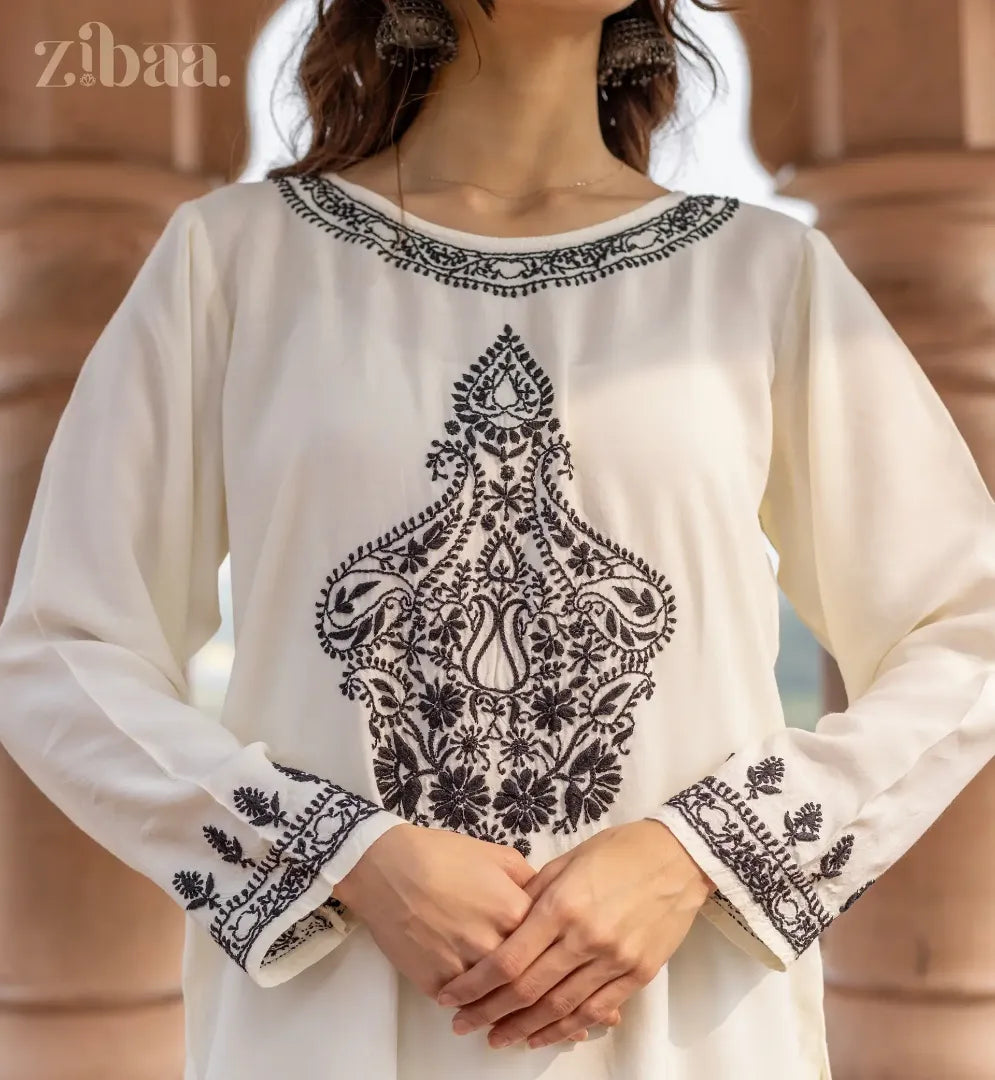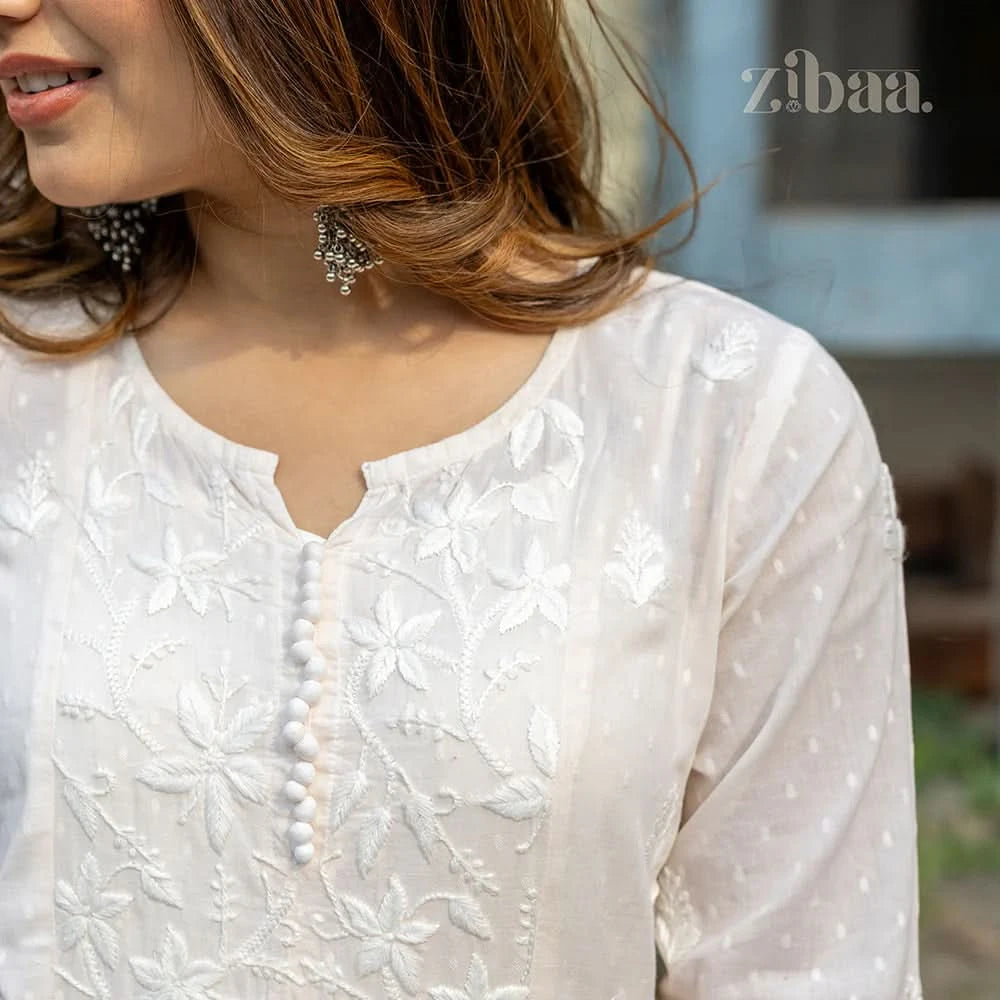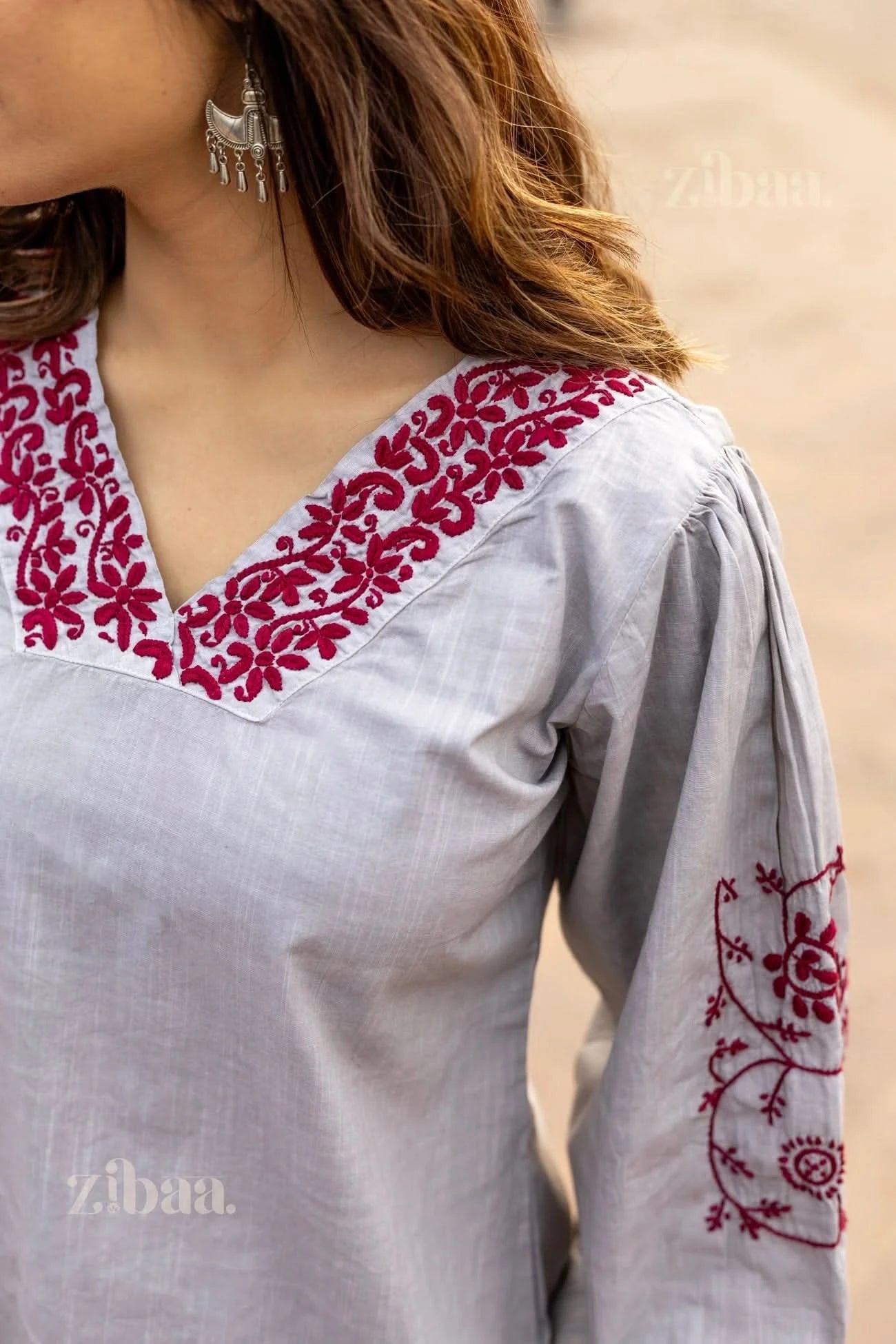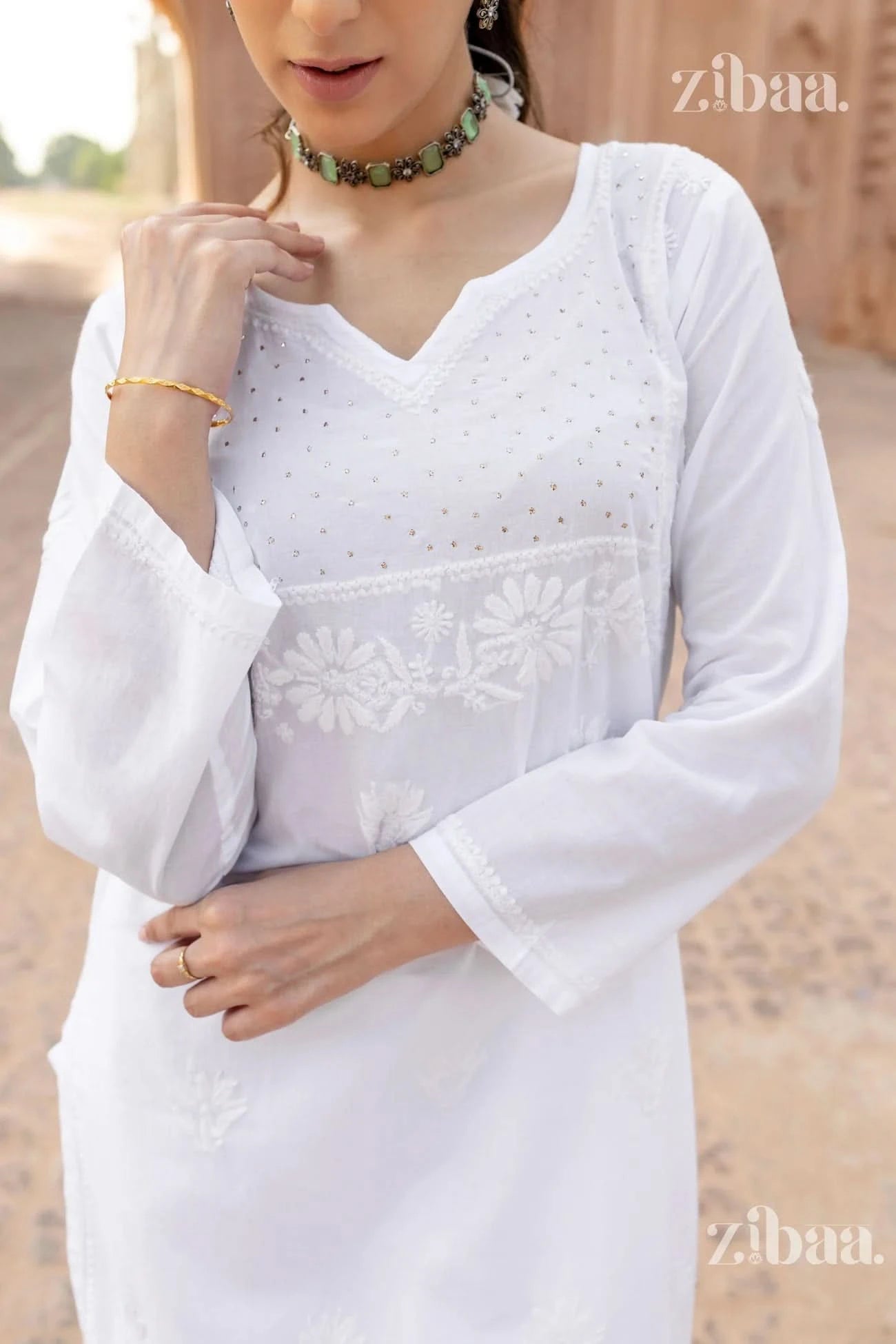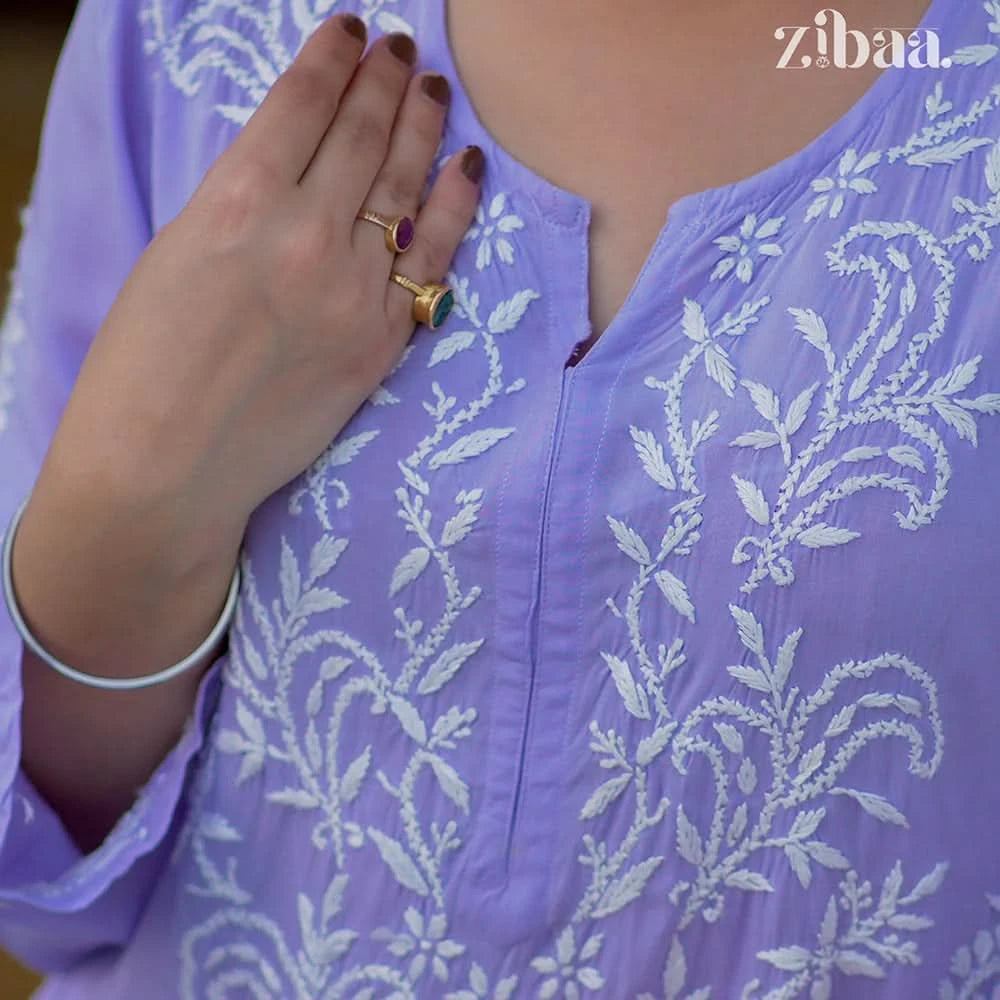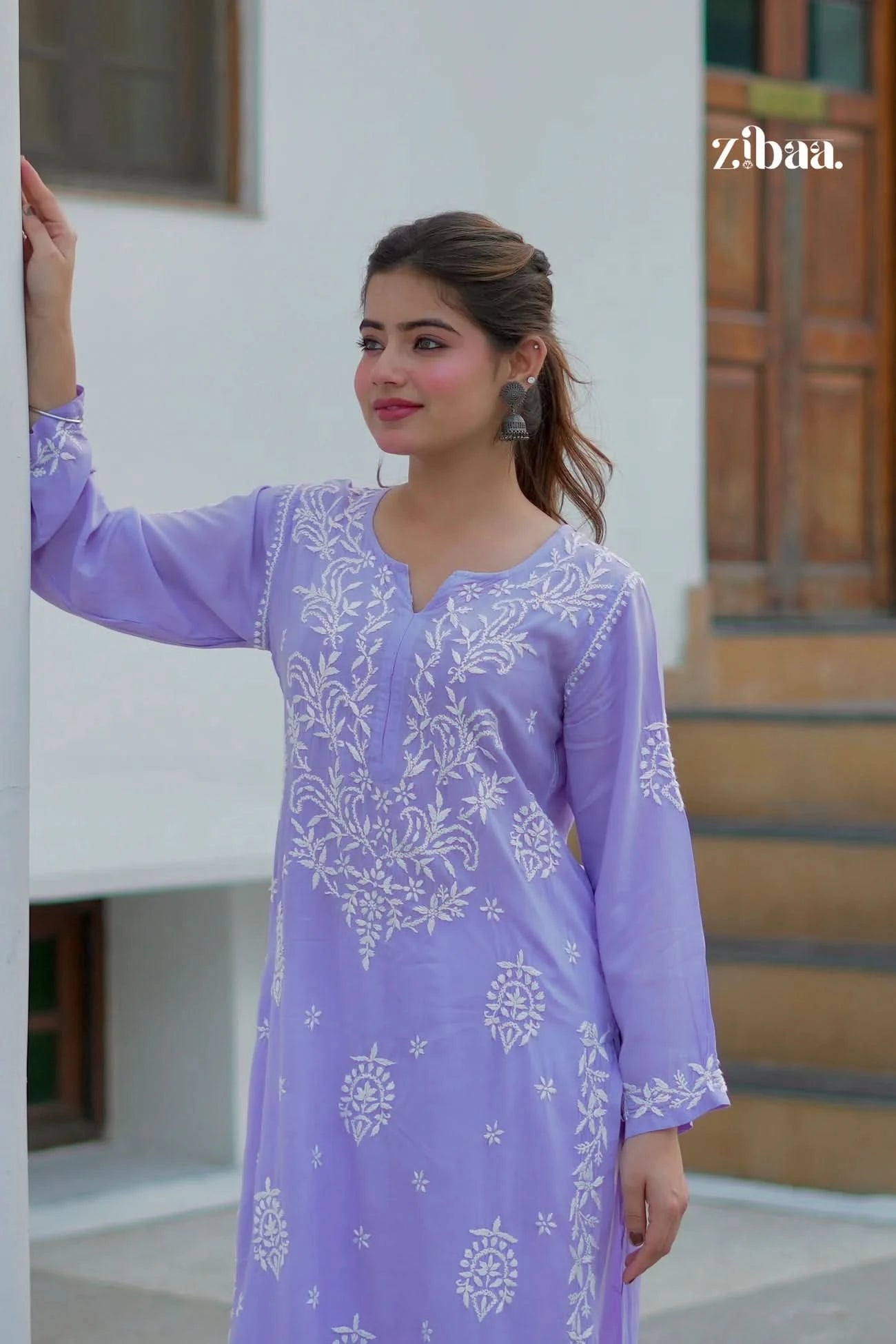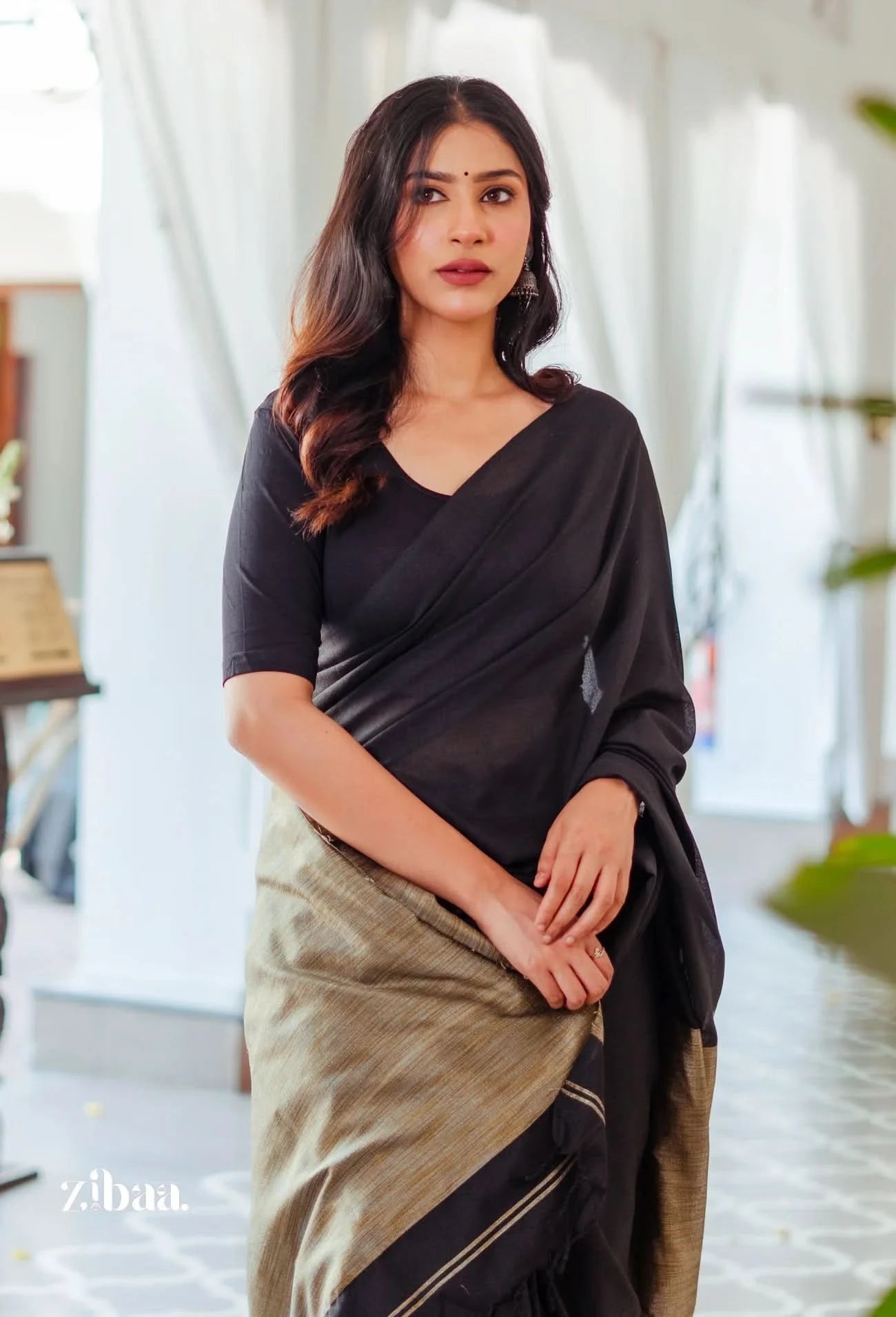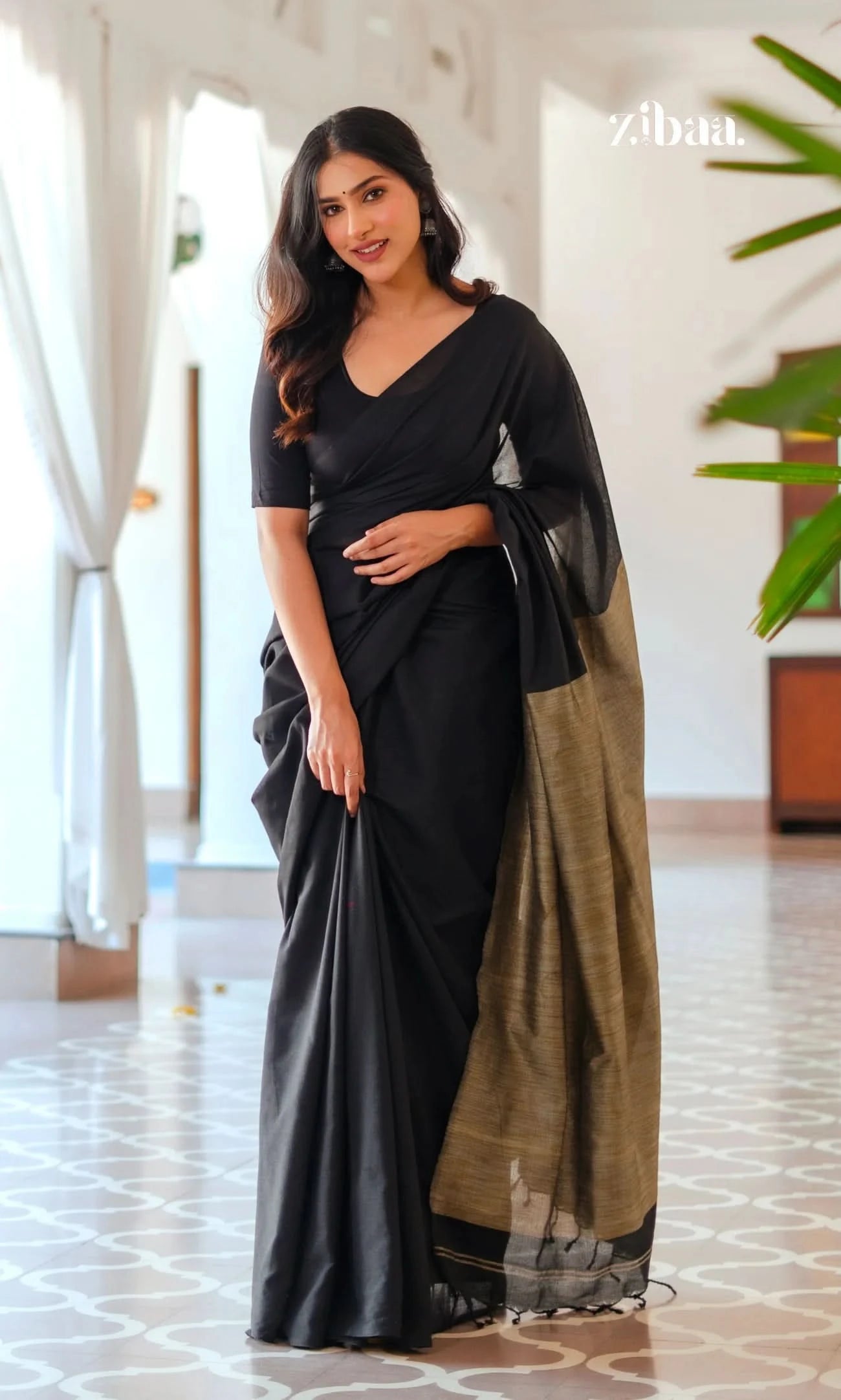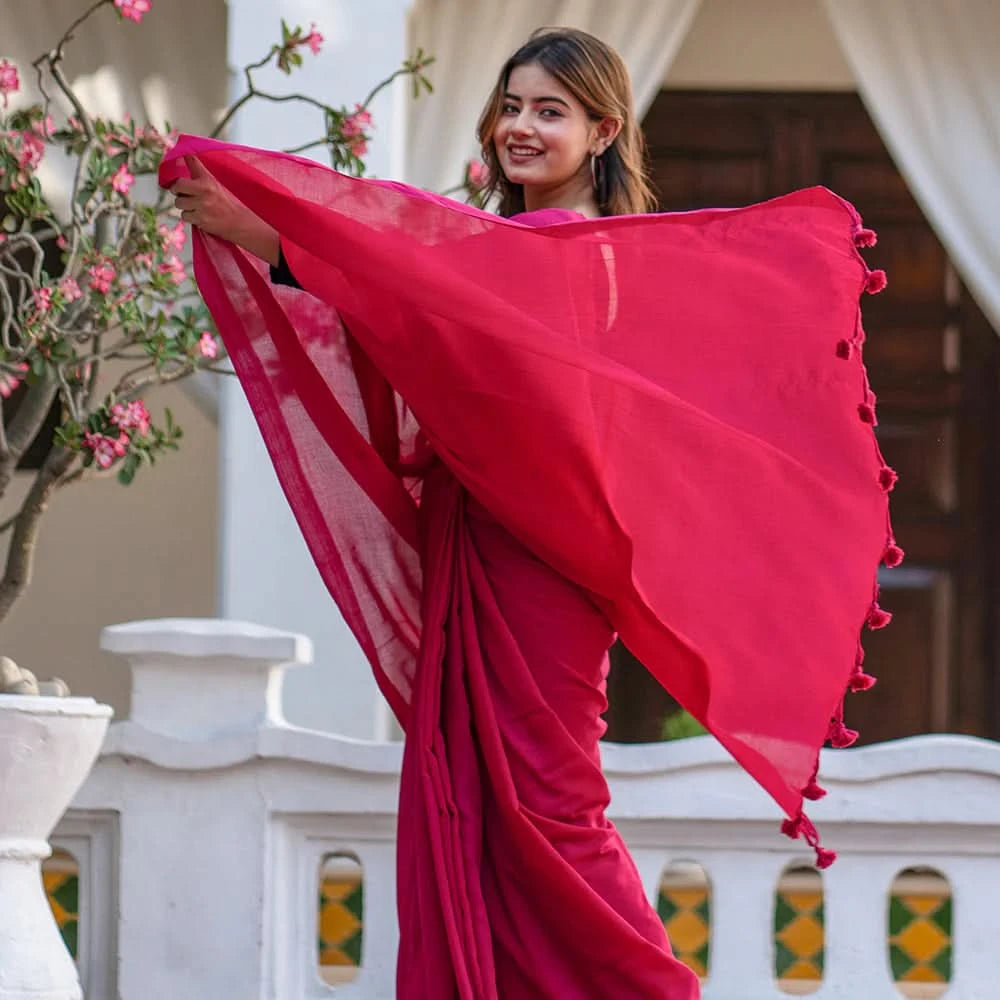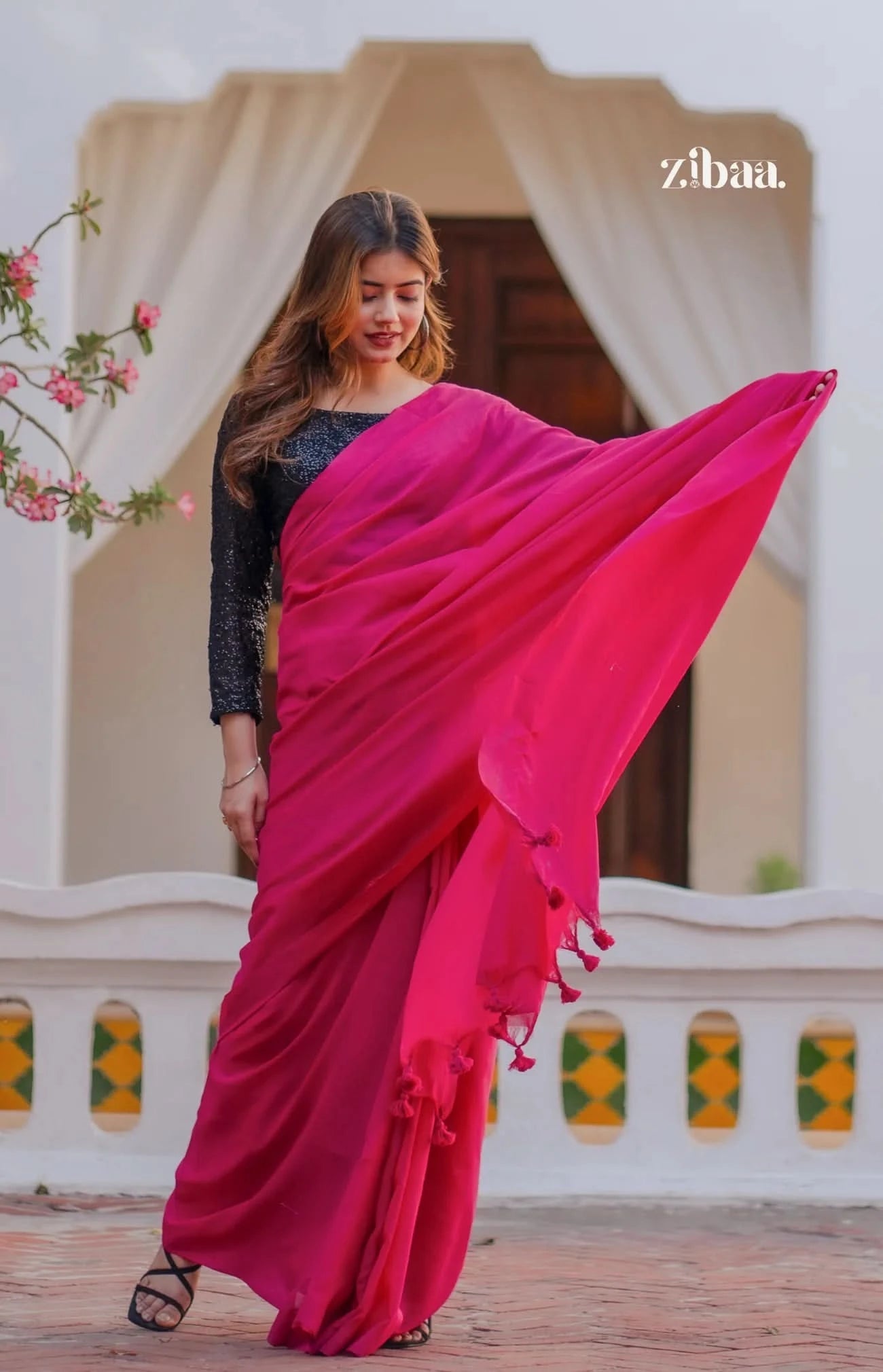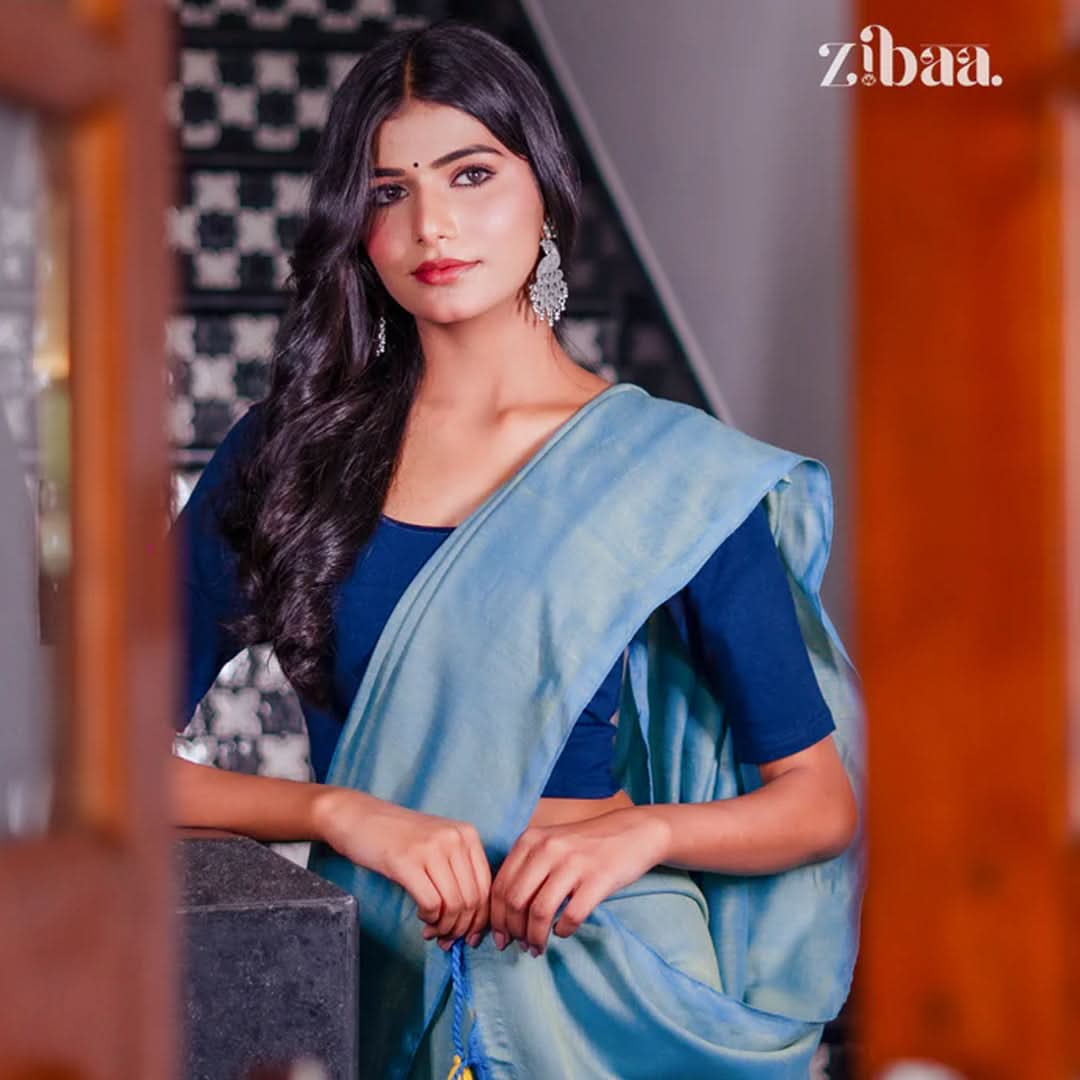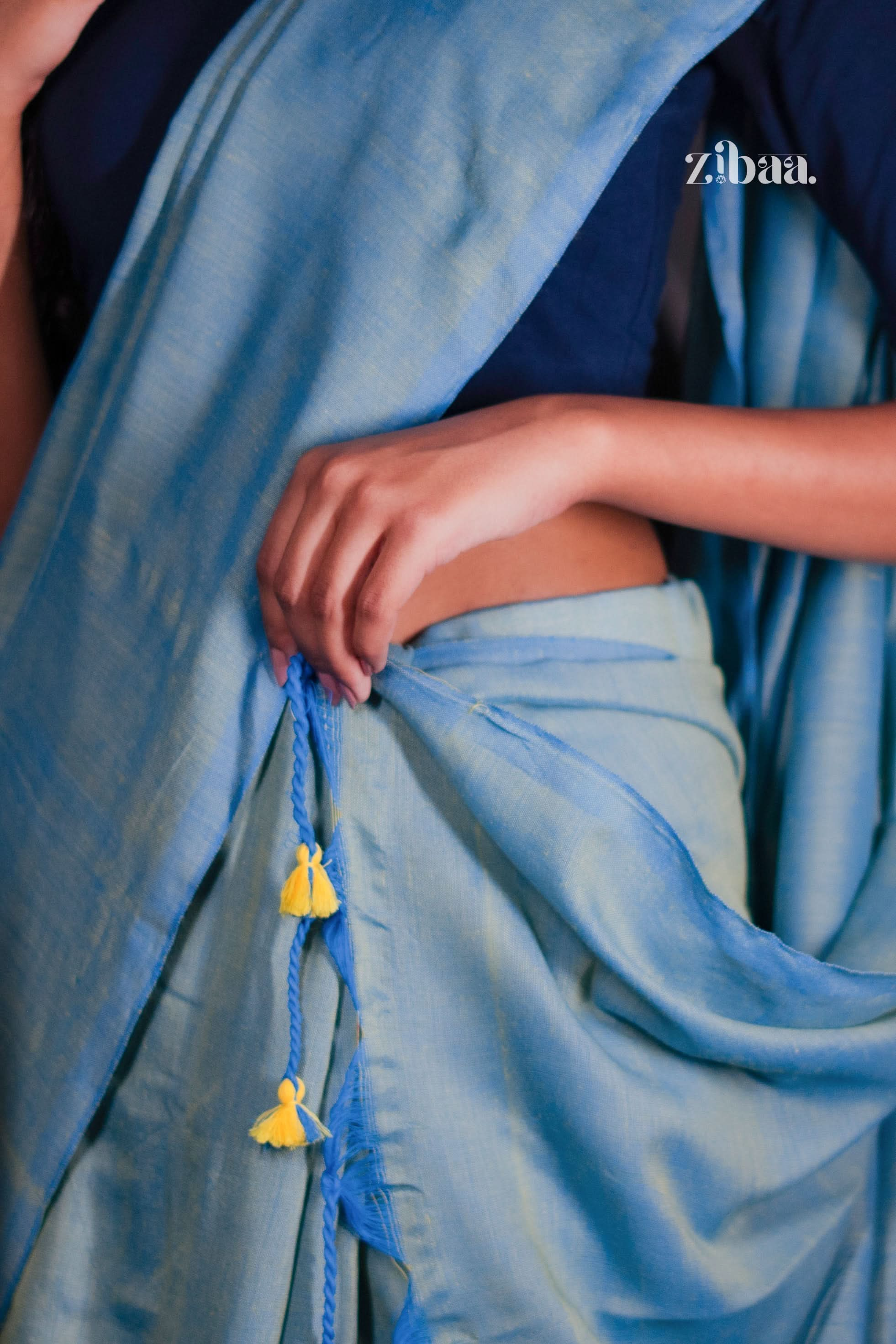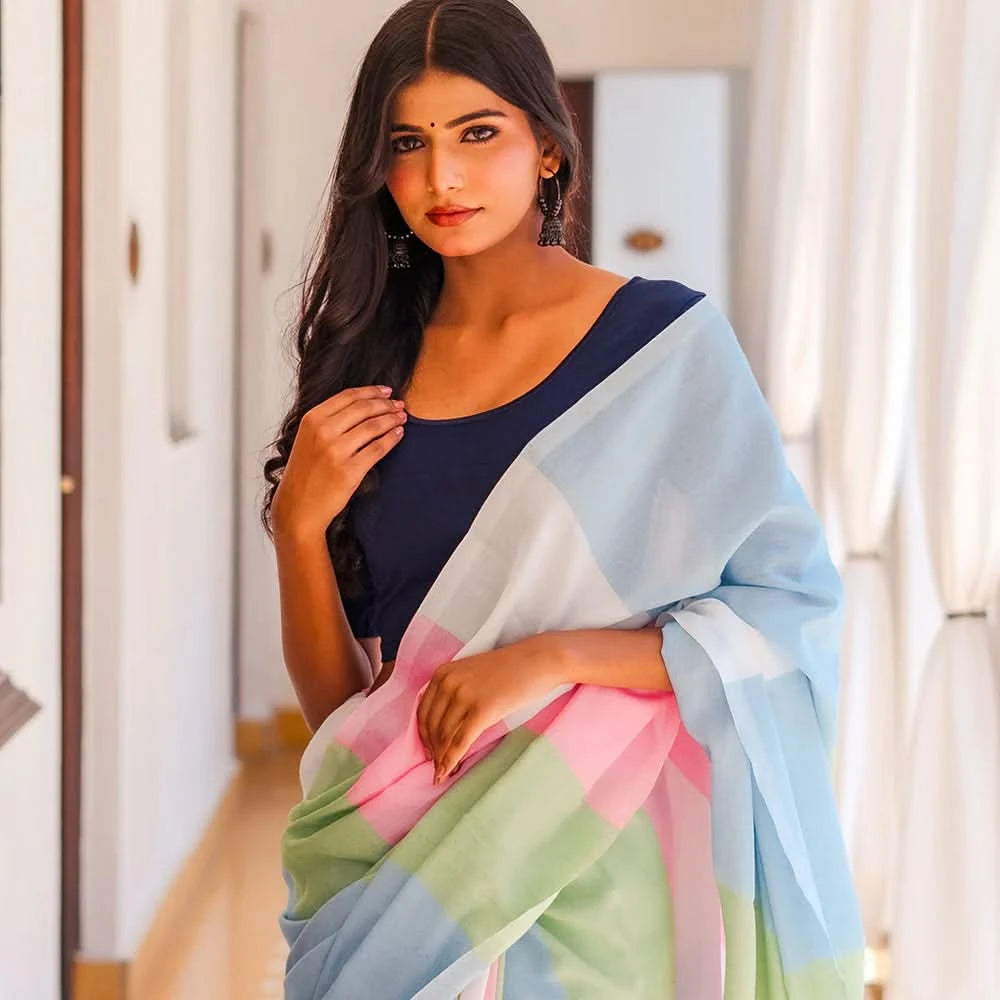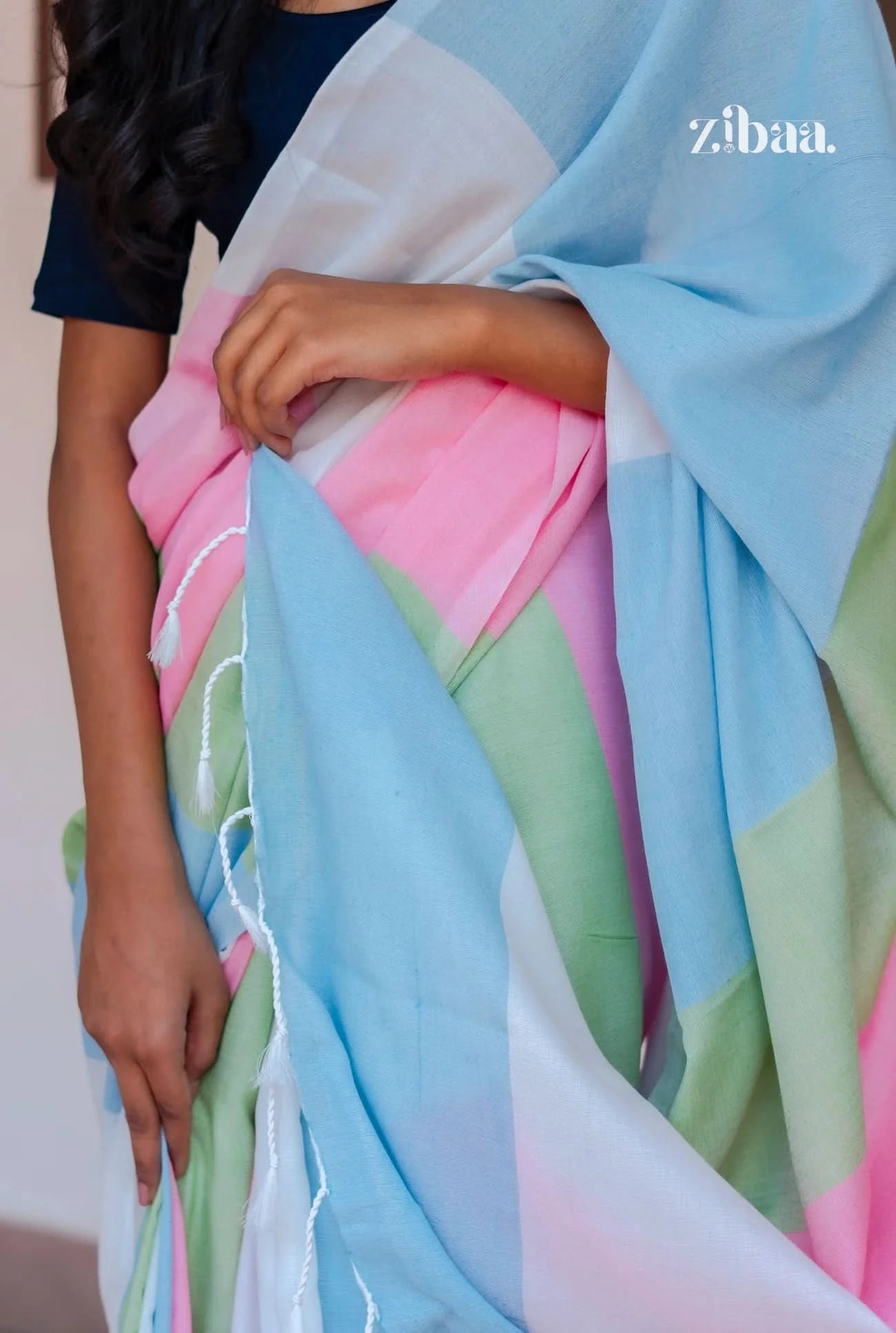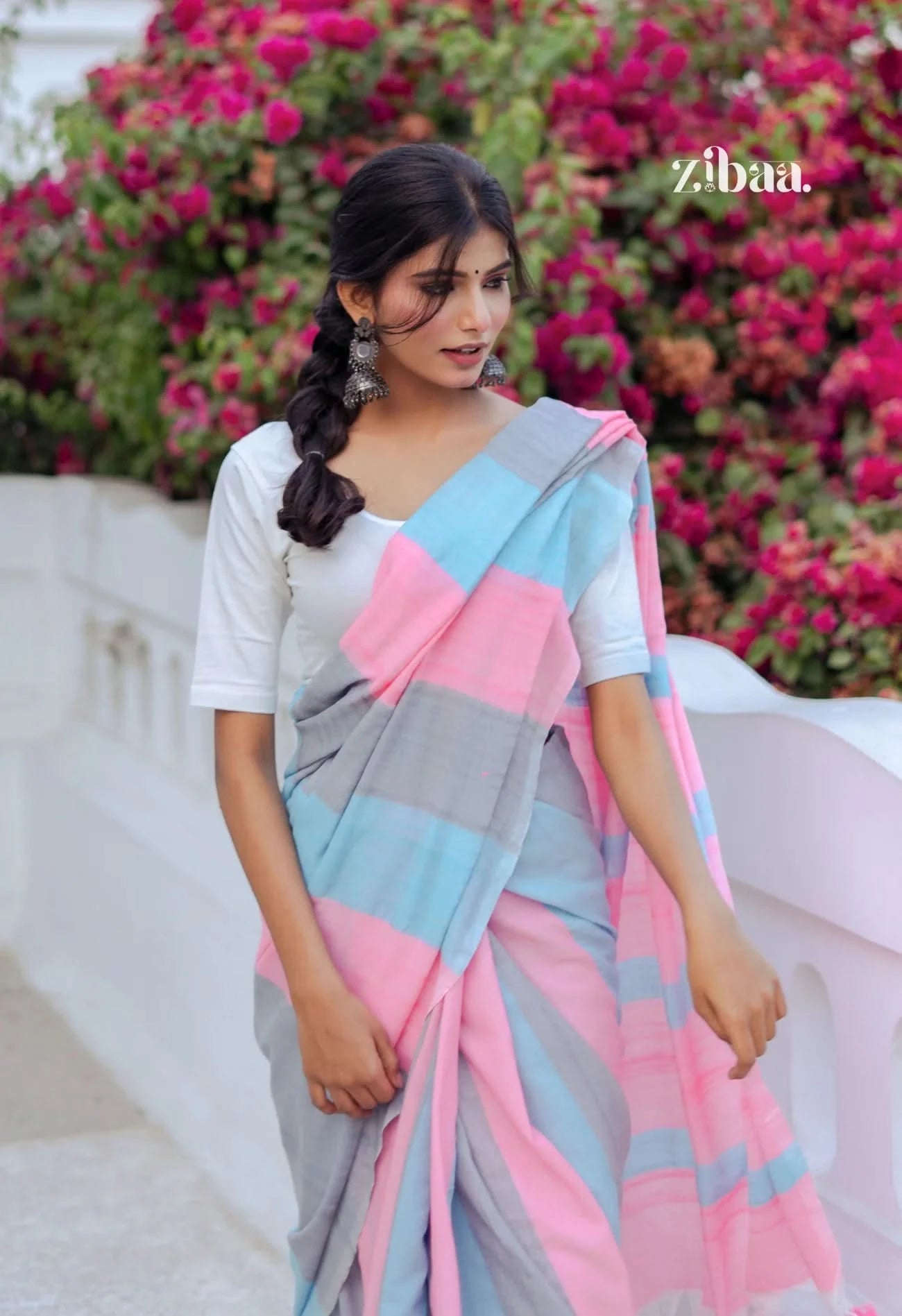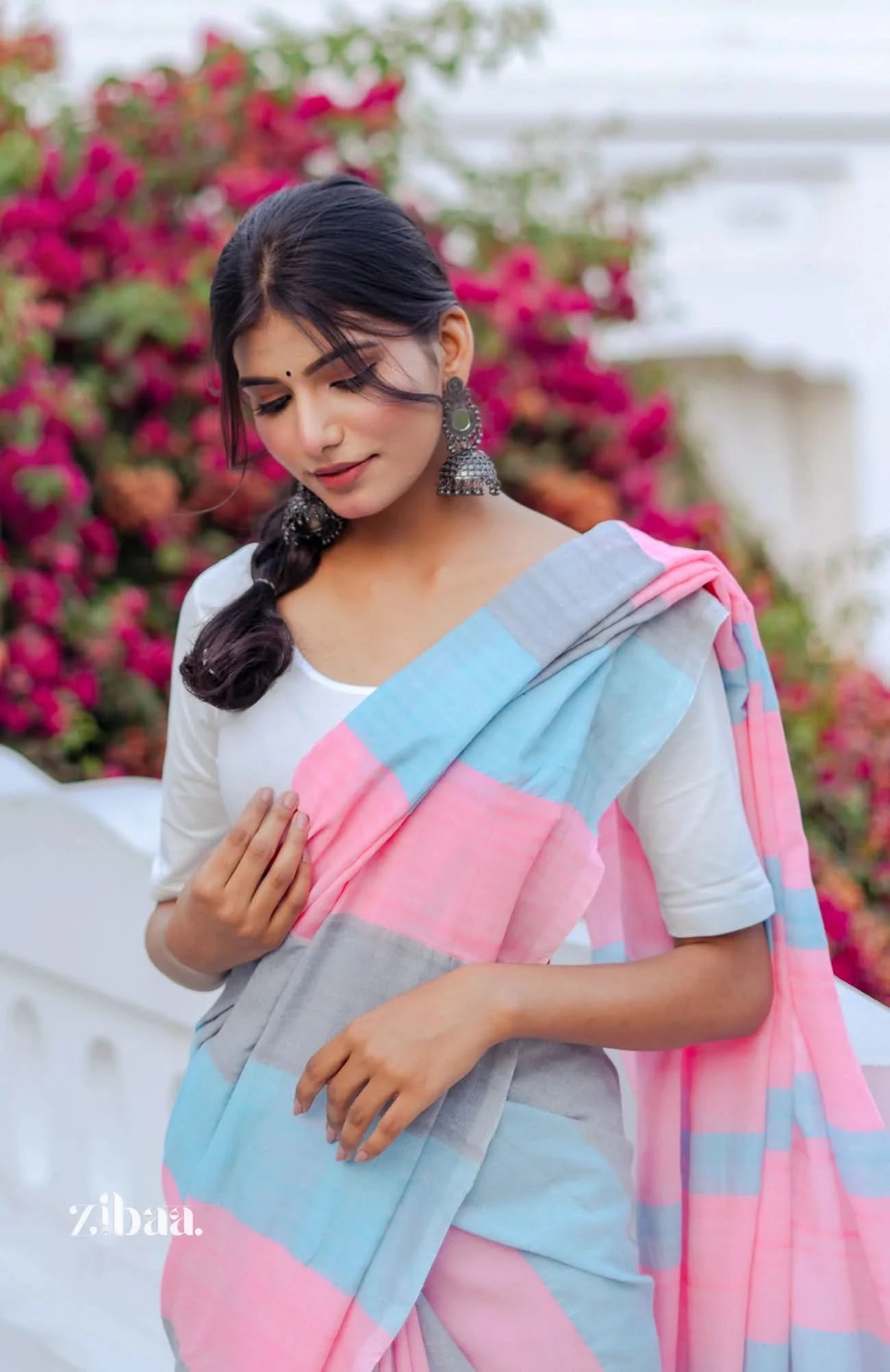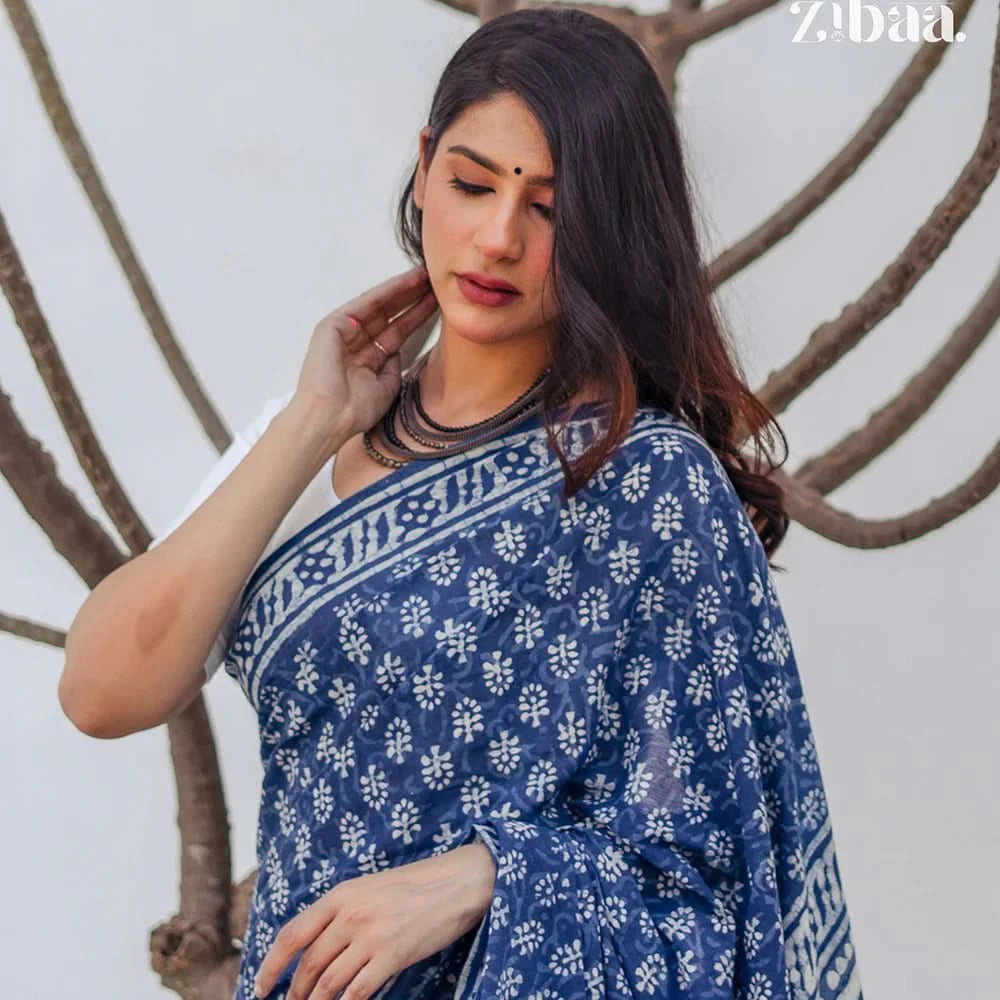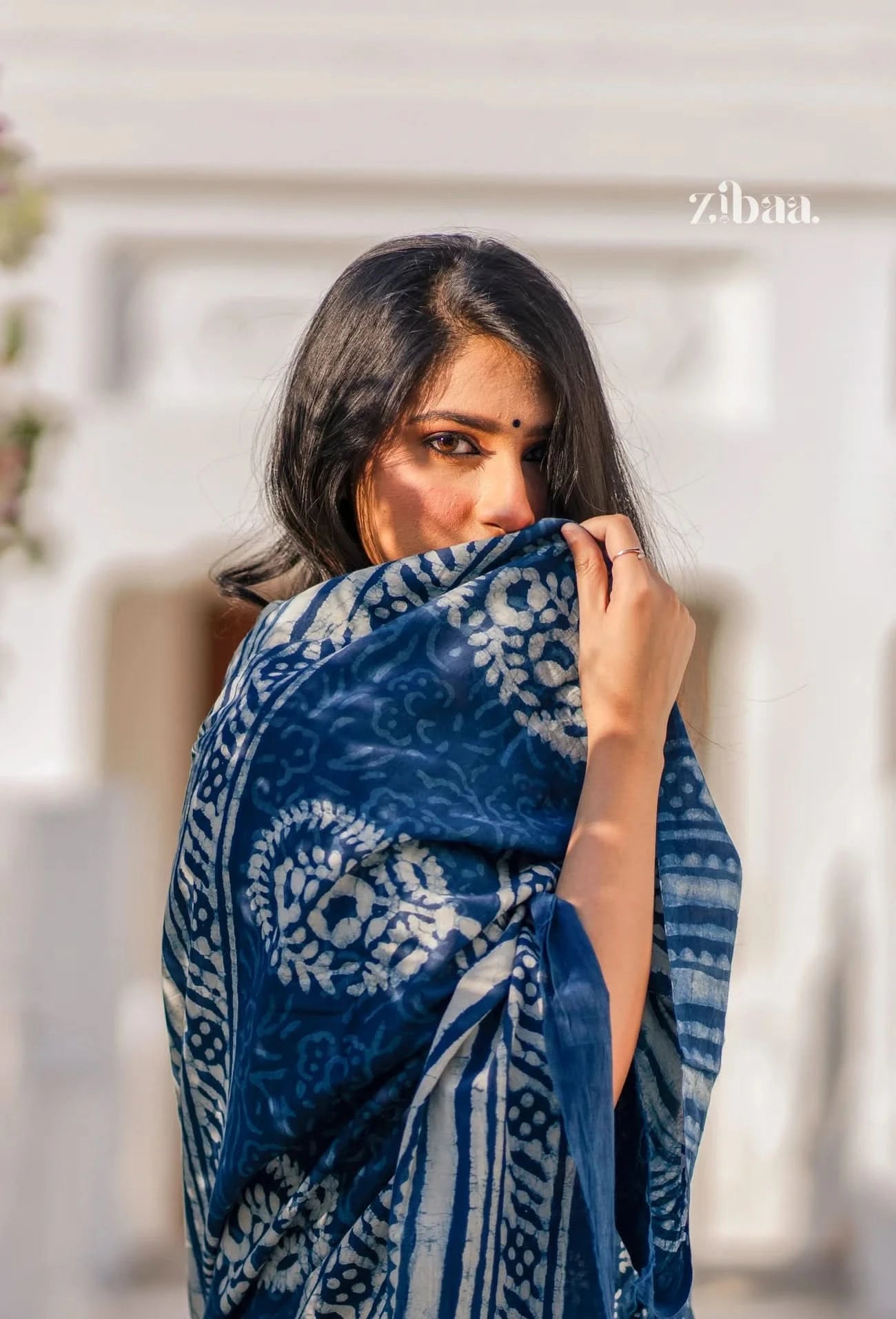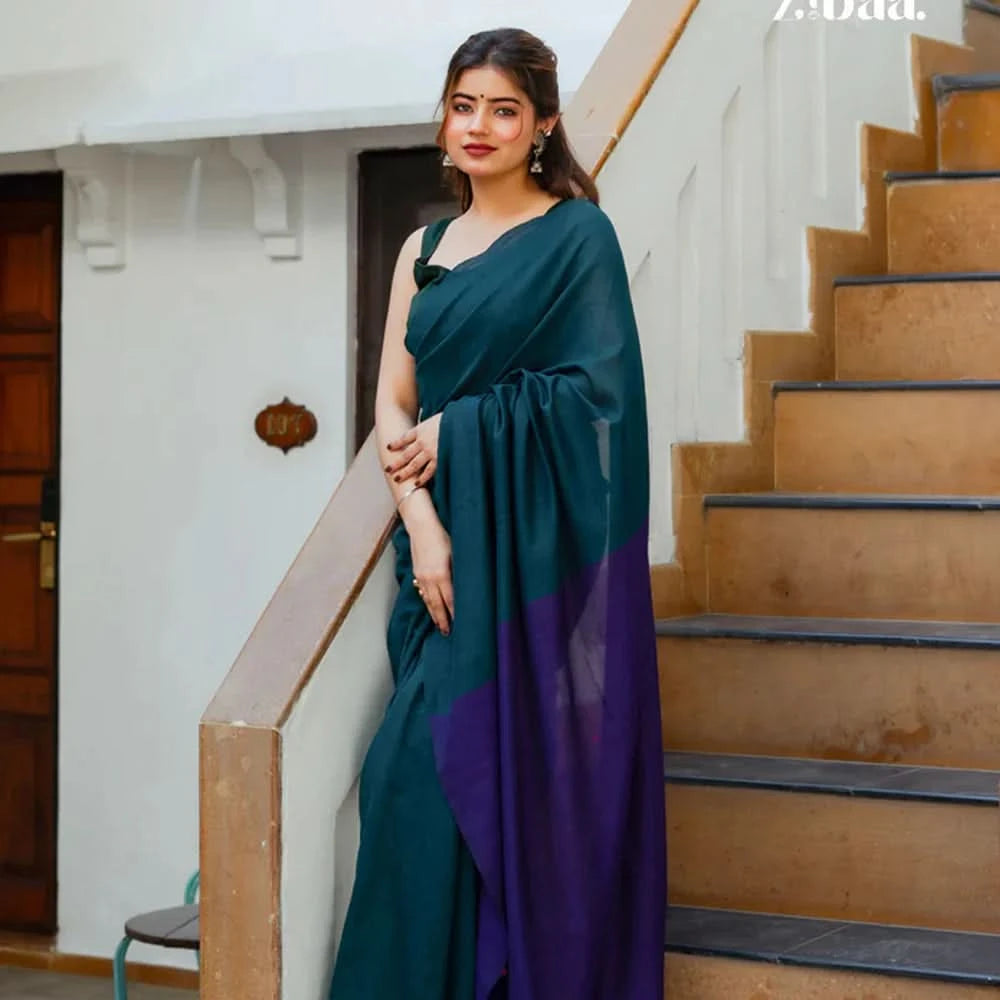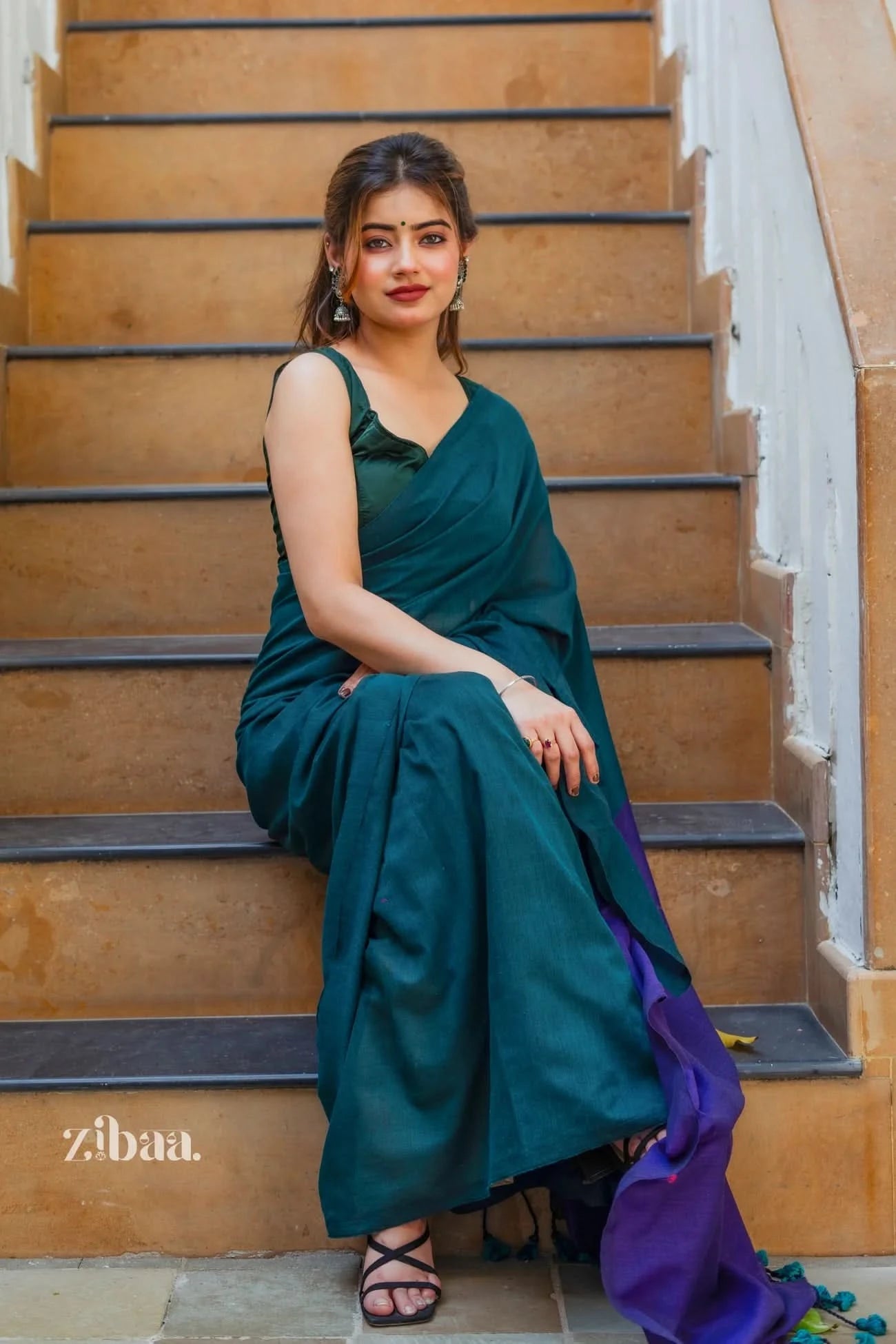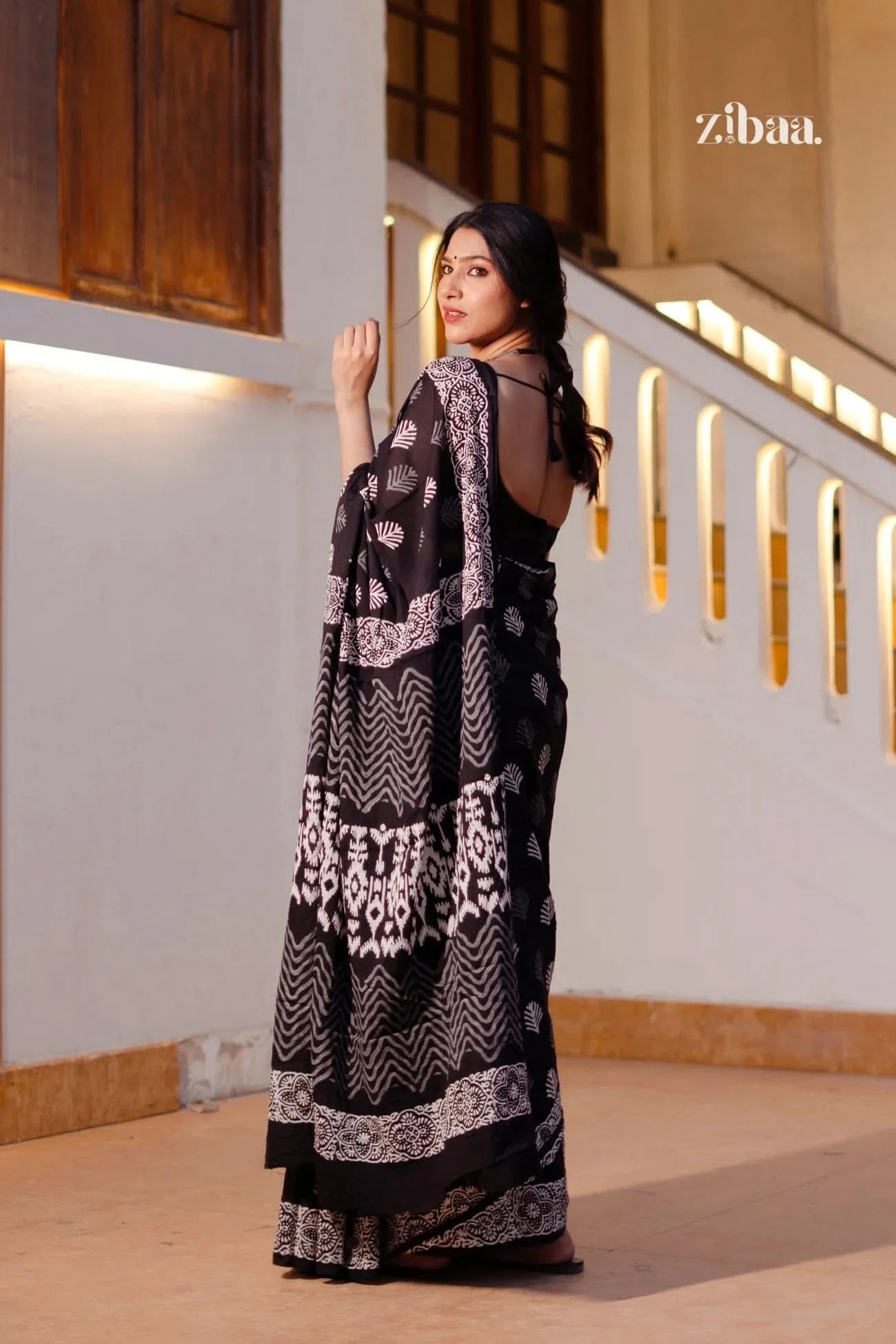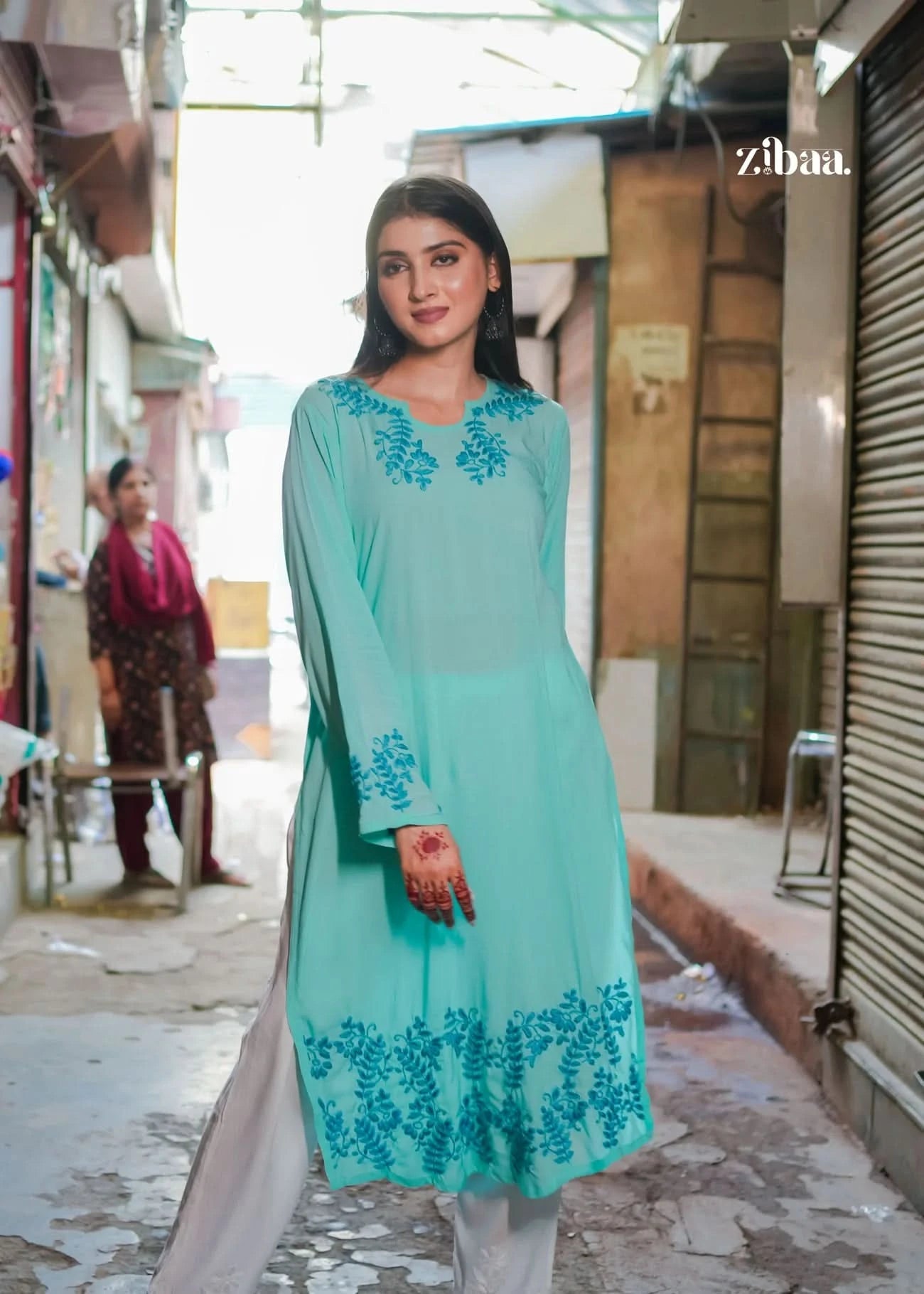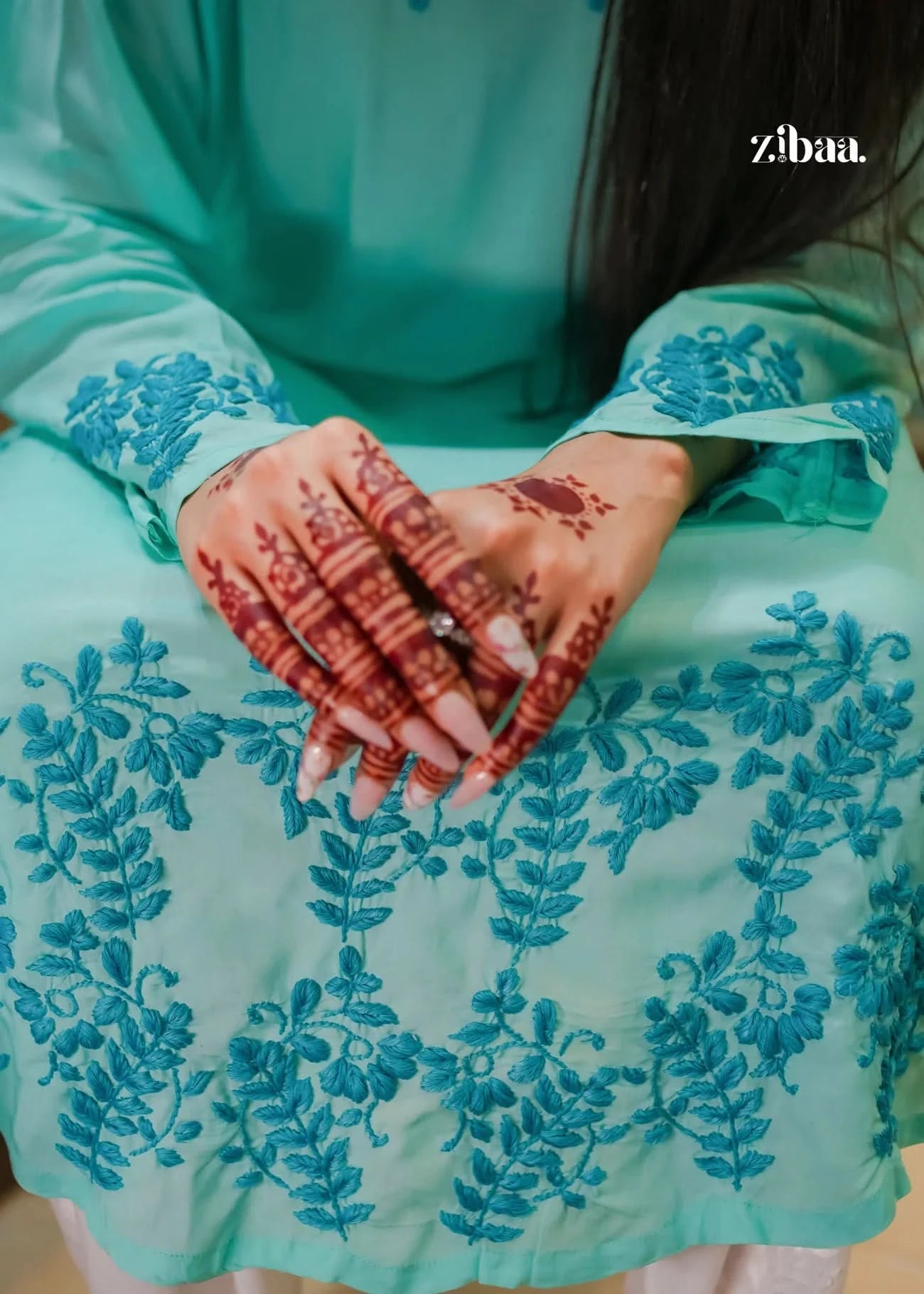The cotton Chikankari kurti reflects the spirit of versatile Indian ethnic fashion. Crafted by master artisans, the highlight of this kurti lies in the meticulously hand embroidered white chikan motifs including bootis, creepers and florals against the soothing off-white cotton fabric. The sheer craftsmanship of detailed jaali and zari borders further elevates its allure. Believed to signify prosperity, the unique patterns are a treat to the eyes.
Tailored to perfection using top quality breathable cotton, this kurti offers superior comfort that lasts. The lightweight fabric drapes softly and the elegant shape with flowy silhouette enhances the comfort quotient. Be it small celebrations or casual evenings, our cotton Chikankari kurti can stylishly carry off any traditional look with ease. Pair with palazzos, leggings, culottes or jeans along with embroidered dupattas and juttis to complete your gorgeous ethnic look. Throw on a contrasting embroidered jacket to ace special occasions. Our cotton kurti also helps provide sustainable livelihood to skilled artisans while preserving the ancient craft of chikan - a matter of pride and identity for Lucknow. This exquisite cotton kurti makes for a thoughtful gift too for your loved ones. The chikankari craftsmanship symbolizes delicate beauty and requires immense passion, patience and creativity - attributes you would want your dear ones to inherently possess as well. It will make them feel truly valued. The vibrant patterns and superior finish gracefully uplifts feminine flair. So ladies, bring home this lightweight wonder designed specifically with keeping your fashion needs and comfort requirements in mind. It is crafted from high quality fabric for that unmatched softness. The pretty ethnic motifs cascading all over make an interesting style statement. So whether it is occasional wear or daily wear, our Chikankari cotton kurti will become your trusted companion and prized possession quickly. They make for an essential addition to your ethnic collections. So bring home this elixir of tradition, comfort and understated elegance. Let art meet comfort and set you apart in the best possible graceful way!
read lessFilters
Filters
Cotton
- 13 productsMaaya Cotton Ivory Chikankari Anarkali
S
M
L
XL
Azal Grey Cotton Chikankari Top
S
M
L
XL
Maaya Mulmul White Chikankari Kurti
XS
S
M
L
XL
XXL
S
M
L
XL
XXL
Default Title
Default Title
Default Title
Default Title
Default Title
Default Title
Default Title
Default Title
S
M
L
XL
XXL
Cotton Chikankari Kurta
Brief history about cotton fabric
Cotton has been used to make fabric for a very long time! People have been spinning cotton into threads and weaving it into cloth for thousands of years. Cotton grows around the seeds of the cotton plant. When the balls of cotton fluff are picked, the seeds are removed and the fluffy cotton fibers are spun into threads. These cotton threads can then be woven on a loom to create cotton fabric.
Cotton fabric keeps you cool in the summer and has been used in warm climates for a long time. In places like India, people have been making cotton clothes for hundreds of years. Traditional Indian clothes like the chikan kurta and chikan kurti are made from lightweight cotton, often white cotton. Chikankari is a type of embroidery done on cotton kurtas and kurtis. It looks beautiful on the soft white cotton. The intricate embroidery makes the cotton kurta or cotton kurti dress look fancy. Chikan work kurtas can be worn as nice casual summer outfits. Short chikan kurtis paired with leggings make great Indian women's wear.
Cotton started being used extensively in Europe during the 1770s, allowing more people to afford more clothes. Before cotton, most clothes were made from more expensive materials like wool, silk, or linen. As trade brought cotton from India and America to Europe, it became the fabric of choice for many common clothes. This inspired the saying “cotton is king” since it became so popular for making affordable textiles.
Cities which are the major producer of cotton fabric in India
India makes a lot of the world's cotton fabric, especially for traditional Indian clothes like chikan kurtas and kurtis. The northern part of India has many cities that are famous centres of cotton textile production. These cities have a long history of making cotton fabric by hand, though nowadays factories also help speed up production.
Kanpur in Uttar Pradesh is called the “Manchester of the East” because it has been a major cotton industry hub for over 200 years. Many cotton textile mills operate in Kanpur today, but traditionally, the handloom weaving industry was also focused here. The fine muslins and light cottons produced in Kanpur were perfect for chikan embroidery, which is popular on kurtas and kurtis.
Another UP city, Etawah, has also gained fame for its handloom-woven cotton textiles. Chikan garments from Etawah often feature intricate embroidery in white thread on white cotton fabric. White cotton chikan kurtas and kurti sets are classic Indian fashion made beautifully by the craftspeople of this city.
Modinagar and Hathras are two more UP cities producing cotton fabric and chikan work clothing. In Hathras, you'll find workshops making cotton thread and handlooms weaving white cotton ready for chikankari embroidery. The artisans even embroider directly onto cotton saris here.
Moradabad cotton textiles are also famous. Black cotton fabric produced here serves as the base for stunning, brightly coloured chikan embroidery in floral and paisley patterns on kurtis. Nearby, Bareilly features cotton handloom weaving and chikan work embroidery on fabric exported across India and worldwide.
Year on year production of cotton fabric in India
Here is the table that represents cotton fabric production city wise
|
Year |
Mumbai |
Surat |
Ludhiana |
Tiruppur |
Ahmedabad |
|
2018-19 |
50,000 |
45,000 |
40,000 |
38,000 |
42,000 |
|
2019-20 |
52,000 |
46,000 |
41,500 |
39,500 |
43,000 |
|
2020-21 |
54,000 |
47,500 |
42,000 |
41,000 |
44,500 |
|
2021-22 |
56,000 |
49,000 |
43,000 |
42,000 |
46,000 |
|
2022-23 |
58,000 |
50,500 |
44,500 |
43,000 |
47,500 |
Here is the table that represents overall cotton fabric production
|
Year |
Overall Production (tons) |
|
2018-19 |
215,000 |
|
2019-20 |
222,000 |
|
2020-21 |
229,000 |
|
2021-22 |
236,000 |
|
2022-23 |
243,500 |
Cotton Chikankari Kurta : An overview
The chikankari kurta is a classic piece of Indian clothing that is loved for its beauty and versatility. Chikankari refers to a special kind of white-on-white embroidery done on soft, breezy cotton fabric. Cotton has been used for centuries to create clothing in India because of the hot climate. The light, breathable cotton fabric allows air to pass through, keeping the wearer cooler. To make cotton chikankari kurti set, first, the cotton is hand-spun into threads and hand-woven into crisp white fabric on traditional looms. Then, artisans use white thread to embroider intricate designs onto the fabric with precise needlework.
Chikankari embroidery has recognisable motifs like flowers, leaves, birds and geometric patterns that decorate the collar, sleeves, hems and front of the kurta. The white-on-white style looks clean and elegant, allowing the stitchwork to stand out. Artisans have passed down their specialised embroidery skills in places like Lucknow, where chikan embroidery originated, for generations.
While classic chikan kurtas feature neutral white on white, some also have colorful accents and embellishments. Black cotton chikankari kurtas make the white stitching pop against the dark background. Pale-colored threads can be used instead of stark white. Beads, mirrors, and gold or silver threads add some sparkle, too, in festive designs.
Women often wear chikankari kurtas with leggings as a set or over pants or jeans. Lightweight chikan fabric is also used to make coordinating dupattas, scarves, and stoles to complete the outfit. Other than women, men team up their chikankari kurta with churidar pants or dhoti for traditional Indian style. With endless ways to style them, cotton chikan kurtas are perfect for casual summer, festivities, or formal events both in India and globally.
From runways to high streets across the world, the versatile cotton chikankari kurta appeals to fashion lovers everywhere. The cool, breathable cotton is comforting, while the artistic embroidery looks sophisticated. Lucknowi chikankari remains in high demand as a summer staple that conveys the heritage of Indian craft. Classic or contemporary, chikan kurtas crafted from pure cotton will always represent beauty through simplicity.
Detailed process of making a cotton chikankari kurta
The elegant and luxurious cotton chikankari kurta is truly a work of intricate artistry and skillful craftsmanship. Various skilled artisans and craftspeople follow many careful steps to transform plain cotton into a beautiful garment decorated with delightful hand embroidery. Here is the process of making a cotton chikankari kurta:
|
Spinning Cotton Thread |
Skilled workers take the cleaned tufts of cotton and use old fashioned hand charkhas or spinning wheels to twist them into fine, durable cotton threads by running their fingers along the fibres as it spins. |
|
Dyeing |
For traditional white chikankari, cotton threads are dipped into vats of bleaching agents multiple times to remove colour until they become a bright, snowy white perfect for delicate embroidery. |
|
Weaving Fabric |
On creaky wooden looms inside independent workshops and factories, weavers feed the strong cotton threads horizontally and vertically to interlace them into long reams of cool, lightweight fabric with a subtly wrinkled texture. |
|
Cutting and Stitching the Kurta |
Using paper patterns, tailors neatly and precisely cut pieces like sleeves, front, back, and yoke from handloom cotton. Then, using sewing machines, they stitch these together with care into a complete kurta shape. |
|
Washing Finishing |
Laundering helps soften the cotton chikankari kurti set, removing any excess dye or spin oil and brightening the white fabric again. Starch sprayed on while ironing further stiffens it up to a crisp finish. |
|
Tracing Chikan Designs |
Chikan artisans lightly dust fine white powder over hand-drawn floral or geometric motifs, then transfer these patterns via dabbing onto the fabric, creating a clean guide outline. |
|
Hand Embroidering |
Patiently hunched over her lap for hours, the chikankari embroidery artist stitches super fine white cotton thread into the chain, stem, shadow, and other tiny stitches following the traced design. |
|
Checking Quality |
Eagle-eyed supervisors examine every centimeter of the chikan embroidered cotton, double-checking that each flowing vine and delicate leaf pattern is perfectly neat with no wonky lines or gaps. |
|
Ironing Packaging |
A hot iron gives the finished chikankari kurta sharply pressed, straight seams and edges. Folded gently twice with tissue paper to prevent creases, the exquisite creation is now ready for store delivery. |
5 Reasons why cotton is best suited for chikankari kurta
1. Soft and Breathable Texture
Cotton has a soft, fluffy, airy texture that feels gentle against the skin. The natural fibers allow air to pass through the fabric so it is very breathable. This keeps the wearer cool and comfortable, perfect for hot Indian summers and sweating. The lightweight cotton chikankari kurti for women lets your skin breathe, not getting overly warm.
2. Absorbs Moisture
Cotton cloth readily soaks up moisture or sweat. So, if you sweat even a little bit, the cotton kurta will absorb it, preventing any wet clinginess that makes you feel dirty or soggy. The moisture gets drawn into the cotton fibers instead of just sticking to your skin, making sure you feel fresh for longer.
3. Easy to Clean and Maintain
Cotton kurtas are very easy to wash and care for. They can handle frequent machine or hand washing because the durable fibers don't wear out. Cotton fabric dries up faster than heavy silks or thicker fabrics after a wash or getting wet. Stains come out easily from cotton, too. Overall, pure cotton chikan kurti barely need any special maintenance to keep them clean.
4. Good Canvas for Embroidery
The smooth, plain surface of cotton fabric provides the perfect base for decorating with chikankari embroidery. Cotton has just the right amount of texture for needle and thread to pass through easily without snagging, tearing, or damaging the fabric. Cotton also holds all kinds of embroidery designs sharply rather than stretching out of shape, allowing the fine white stitching to shine.
5. Timeless Graceful Drape
Cotton cloth drapes elegantly around the body and gives a graceful silhouette. Light cotton falls softly over curves for a figure-flattering effect. Natural cotton holds symbolic old-world charm that imbues the chikankari kurta with vintage traditional beauty. When embroidered, the handloom cotton gains further nostalgic royalty in its fluid drape.
So, from providing comfort next to the skin and graceful flow to retaining bright designs and withstanding tough use, cotton’s natural properties are uniquely suited to chikankari kurtas. Handloom cotton fabric marries heritage charm with functionality - that's why chikankari looks and feels best when crafted on pure cotton material.
Trending colours for cotton chikankari kurta in summers
1. White Cotton Chikankari Kurtas
Crisp white is hands down the most iconic colour for chikankari. The stunning white-on-white embroidery contrasts beautifully with the bright white cotton fabric. White chikan work reflects light and grabs attention from a distance without being loud. It has a clean, breezy look that is perfect for harsh Indian summers while still looking gracefully traditional for occasions, temple visits, or weddings. Pure white projects innocence and peace - no wonder it is worn at ceremonies or by politicians. Stay effortlessly put together this summer with lightweight white cotton chikankari kurtas!
2. Black Cotton Chikankari Kurtas
If you want something smarter than plain white, go for cotton black chikankari kurti with identical white stitching. The embroidery pops brightly against the darker shade. Black is bold yet still comfortable for daily Indian wear. Combined with chikan, black cotton kurtas allow you to make a stylish statement while beating the heat. Black reflects light rather than absorbing heat from the sun like darker shades. Cotton stays breezy, while black adds a sophistication. Elevate evenings or dinner dates with these modern pure cotton chikan kurti.
3. Blue Cotton Chikankari Kurtas
Blue is always among the hottest hues, and it looks so refreshing for summer! From pretty pastels to festive indigo shades, blue cotton chikankari kurtas range from sweetheart-y to sophisticated. Pale powder blue with white chikan embroidery boosts a soft girl-next-door vibe. Navy blue cotton sets make sharp ethnic outfits for after-dark events. Denim blue cotton chikankari short kurti even give off a fusion, boho effect. Not just flexible style-wise, blue is also a naturally calming and tranquil colour, suiting relaxed vacations or staycations this summer!
4. Yellow Cotton Chikankari Kurtis
Add a burst of sunshine to your wardrobe with vibrant yellow cotton chikankari kurtis! Cheerful yellow boosts mood and energy, ideal for battling summer fatigue or dullness. The lively, citrusy colour resembles mango season and traditions like wearing yellow on Basant Panchmi. Boost confidence with these feel-good contemporary chikan kurtis. In Indian culture, yellow is also associated with welcoming guests, so wear it when hosting parties or family events. Paired with white embroidery, yellow cotton looks extra radiant while keeping the heat at bay.
Interseting ways in which you can style your cotton chikankari kurta
Here are the exciting ways to style your cotton chikankari kurta for women:
1. Kurta with Jeans
Who says you can’t fuse Indian and Western wear? Pair your long or short chikan kurta with casual blue or black jeans for an effortlessly cool fusion outfit. This works well for a fun everyday look or relaxed outings with friends. Choose neutral-toned kurtas to let the playful mix of cultures shine through.
2. Kurta Over Maxi Skirt/Dress
Cotton chikan kurtas lend delicate embroidery to balance and elevate free-flowing maxi skirts or dresses beautifully. Pick a neutral full-length skirt or boho-printed maxi dress in breathable fabric like cotton or chiffon. Layer your favorite chikankari kurta on top—a feminine, dressy summer outfit ready in moments!
3. Kurta with Palazzos
Palazzo pants cut straight through the leg look super modern and slimming. Team these with a short chikankari kurta in a contrasting color, like an icy blue kurta atop white palazzos. Add oxidised silver jewellery and kolhapuri wedges for an on-trend Indian fusion outfit.
4. Simple Kurta with Churidar Leggings
Keep it simple but elegant with classic churidars and your favourite chikankari kurta in one colour family. Go for lightweight pastel hues or all-white to beat the heat in style. Add bangles, hoops earrings and a potli bag for a fuss-free, traditional look.
5. Kurta with Patiala Pants
Patiala pants lend a royal vibe with their billowing silhouette. Pair these with solid colored chikan kurtas, choosing glossy satin patialas for nightwear or soft cottons for daytime ethnic wear. Embrace regal Indian heritage with these opulent pieces.
6. Short Kurta Over Denims
Another no-fuss way to rock short chikankari kurtis is wearing them over blue or black jeans with funky flats or white sneakers for college. This bright casual look works well for daily wear or casual dates without going OTT Indian.
7. Long Kurta with Dhoti/Pants
Lastly, do as the men do by teaming full-length cotton chikankari kurtas with classic Indian dhotis or pants. This adapted ethnic look makes a comfortable traditional outfit for festivals, prayers or family functions.
With these inspirational ideas, you can reinvent your old chikankari wardrobe by mixing up bottom pieces for modern or traditional fusion styles perfect for summer!


